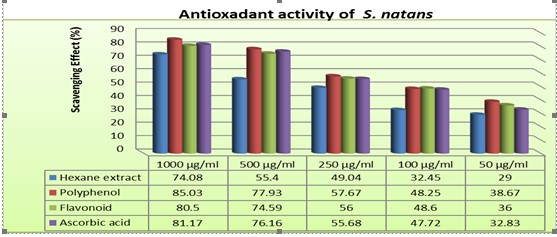Antioxidant activity of some Salvinia natans L. extracts and a study of their efficacy against isolated bacteria from diabetic foot ulcers
Main Article Content
Abstract
Salvinia : is an annual plant floating on the surface of water(aquatic plant).There is only one species in Iraq, is Salvinia natans L., and it spreads in a high density in the southern part of Iraq Floating freely on the water surface in the Iraqi marshes , S.. natans L. is an introduced species . Several tests were used to identify the presence of active chemical compounds in S. natans L. and we note that the S. natans is rich in active substances. showed phytochemical results were found for the extract ethanol 70% contain carbohydrates, flavonoids, phenols, alkaloid, glycosides, and saponin , and negative detection for both Tannin and triterpenoid. Evaluation of antioxidant activity for S. natans extracts by inhibiting the (1,1- diphenyl-2- picrylhydrazyl) radical scavenging activity, , it study results showed that all extracts have antioxidant activity by (1,1-diphenyl-2-picrylhydrazyl) radical scavenging with different concentrations, showed the superiority of the polyphenol 85.03 % inhibition ratio at a concentration of (1000 μg/ml ) , flavonoid 80.5% at a concentration of (1000 μg/) ,and hexane extract 74.08 % at a concentration of (1000 μg/ml) Compared to ascorbic acid, which recorded 81.17% at a concentration of 1000 μg/ml. Whereas, the hexane extract recorded the lowest inhibition rate at concentration of (50 μg/ml) . efficacy showed of separated extracts from S. natans as antibacterial activity using well diffusion plate method. The SF extract was the highest activity against all isolated pathogenic bacteria from foot ulcers of diabetic patients , while the other extracts showed varying activity against different bacterial species at P. value < 0.01. The results of the current study illustrated that SF extract was the high Zone rate of inhibition/mm2(28.3 ± 1.5) against P. aeruginosa, while not any inhibition/mm2 (0.0 ± 0.0) for hexane extract against same of isolated bacteria. HPLC analysis indicated the presence of flavonoid compounds namely Catechine , Rutin ,Kaempferol and Apigenin with specific retention times. The detected compounds possess antioxidant and antibacterial activities. This results suggested that separated extracts from S. natans have high antioxidant and antibacterial activities.In the future, S. natans L.extracts could become one of the important alternatives in treating infections of the throat, skin, urinary tract, and digestive system, even if in a limited way due to the spread of types of microbes that are resistant to antibiotic drugs.

